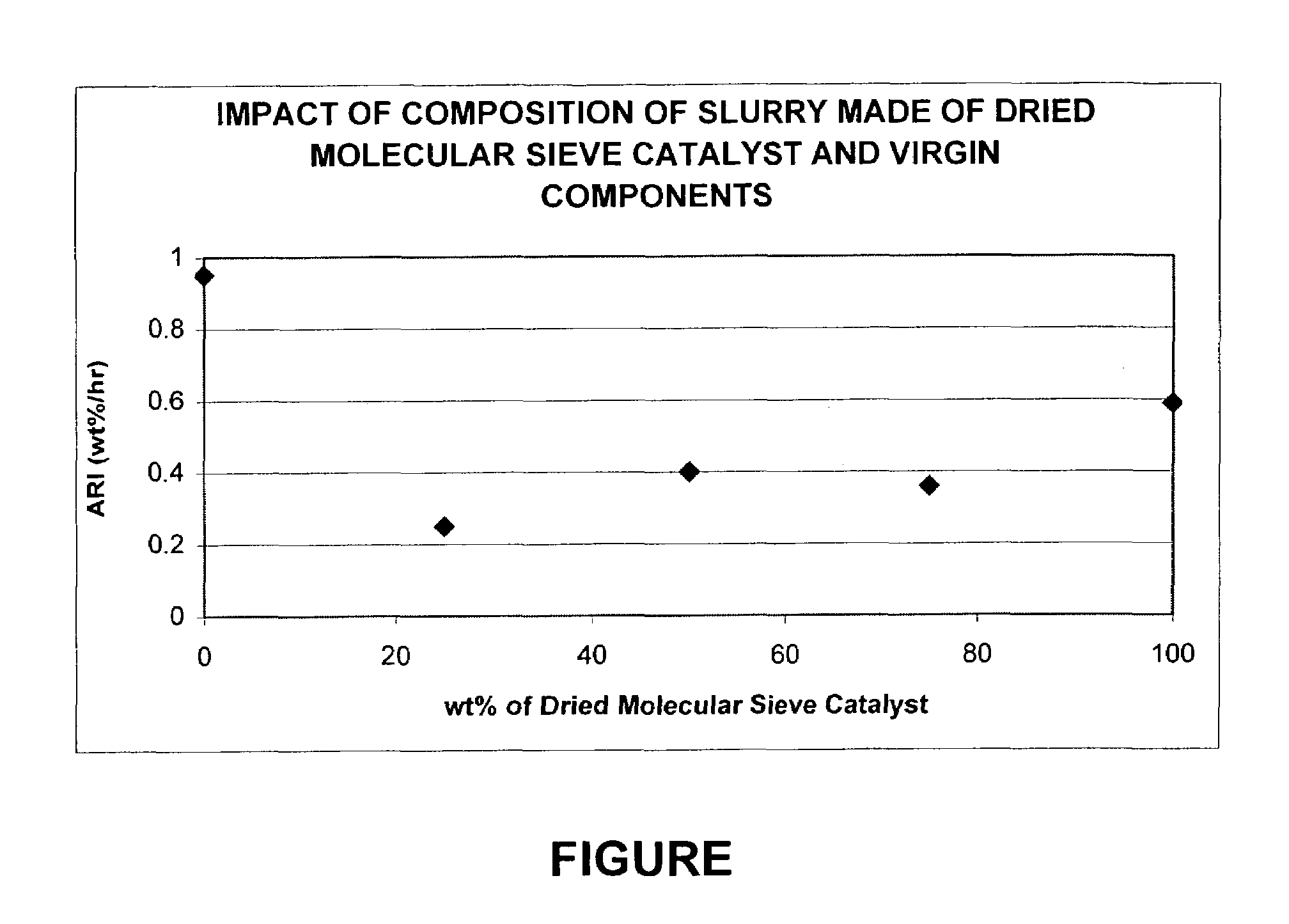Attrition resistant molecular sieve catalysts
a molecular sieve and catalyst technology, applied in the field of attrition resistance molecular sieve catalysts, can solve the problems of difficult to achieve the appropriate hardness of molecular sieve catalysts, the composition of very hard molecular sieve catalysts is not suitable for commercial use, and the conventional method of making molecular sieve catalysts fails to achieve the appropriate hardness for effective commercial use. , to achieve the effect of strong resistance to attrition and high velocities
- Summary
- Abstract
- Description
- Claims
- Application Information
AI Technical Summary
Benefits of technology
Problems solved by technology
Method used
Image
Examples
example-1
[0126]A slurry containing 45 wt % solid was prepared by mixing 1,125 g of a spray dried catalyst (which contained 40% SAPO-34, 10.6% alumina, and 49.4% clay) with 875 g of deionized water using a Yamato 4000D mixer (Yamato Scientific America Inc., Orangeburg, N.Y.) for 10 minutes at 600 RPM. The slurry was then mixed using a high-shear mixer, Yamato L4RT-A (Yamato Scientific America Inc., Orangeburg, N.Y.), at 6,000 RPM for 5 minutes. The resultant final product slurry had a pH of 3.9, and density of 1.45 g / cc, measured at 25° C. The viscosity of the slurry was 2,180 centipoise at 24° C., which was measured with a Brookfield LV viscometer, using a #3 spindle at 10 RPM.
example-2 (comparative)
[0127]700 g of the final product slurry produced in EXAMPLE-1 was spray dried using a Yamato DL-41 spray dryer, operating in a down spray mode, using a 1 mm atomization nozzle. Spray drying conditions were as follows: feed rate, 40 g / min; inlet temperature, 350° C.; atomization pressure, 1 bar; and carrier gas flow at 60% of full setting. Spray dried products were collected in a cyclone, and calcined in a muffle furnace at 650° C. in air for 2 hours. The calcined samples were tested for attrition resistance, and found to have an ARI of 0.59 wt % / hr. The result is shown in the Figure.
example-3
[0128]843.75 g of the spray dried catalyst used in EXAMPLE 1 were added to 656.25 g deionized water, and mixed at 600 RPM using a Yamato 4000D mixer (Yamato Scientific America Inc., Orangeburg, N.Y.) for 10 minutes to produce a slurry. The slurry was then mixed using a high-shear mixer, Yamato L4RT-A (Yamato Scientific America Inc., Orangeburg, N.Y.) at 6,000 RPM for 10 minutes. To this slurry, 168.5 g of SAPO-34 molecular sieve was added, then further mixing was carried out using the same procedure as outlined in EXAMPLE-1. A composition made of 81.06 g of Reheis MicroDry aluminum chlorohydrate (Reheis Chemical Inc., Berkeley Heights, N.J.) and 118.84 g of deionized water was then added, and further mixing carried out using the same protocol outlined in EXAMPLE-1. Finally, 131.57 g of kaolin clay (Engelhard USP kaolin clay, Engelhard Corporation, Iselin, N.J.) was added and further mixing carried out using the same routine as in EXAMPLE-1. This resulted in a final product slurry co...
PUM
| Property | Measurement | Unit |
|---|---|---|
| pH | aaaaa | aaaaa |
| particle size | aaaaa | aaaaa |
| diameter | aaaaa | aaaaa |
Abstract
Description
Claims
Application Information
 Login to View More
Login to View More - R&D
- Intellectual Property
- Life Sciences
- Materials
- Tech Scout
- Unparalleled Data Quality
- Higher Quality Content
- 60% Fewer Hallucinations
Browse by: Latest US Patents, China's latest patents, Technical Efficacy Thesaurus, Application Domain, Technology Topic, Popular Technical Reports.
© 2025 PatSnap. All rights reserved.Legal|Privacy policy|Modern Slavery Act Transparency Statement|Sitemap|About US| Contact US: help@patsnap.com

